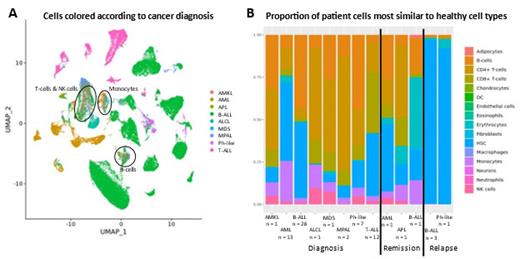Leukemia is the most common pediatric cancer, diagnosed in over 3,000 children annually in the US. While the prognosis for many pediatric leukemias has significantly improved with the addition of DNA sequencing to the diagnosis and treatment selection process, the molecular mechanisms driving some cases remain inscrutable. In this study, we performed single-cell RNA sequencing on a cohort of pediatric leukemia samples (n = 72) to explore intra- and inter-patient heterogeneity across multiple types of malignancies: acute megakaryoblastic leukemia (AMKL, n = 1), acute myeloid leukemia (AML, n = 14), acute promyelocytic leukemia (APL, n = 1), B-cell acute lymphoblastic leukemia (B-ALL, n = 32), anaplastic large cell lymphoma (ALCL, n = 1), myelodysplastic syndrome (MDS, n = 1), mixed phenotype acute leukemia (MPAL, n = 2), Ph-like B-cell acute lymphoblastic leukemia (Ph-like, n = 8), and T-cell lymphoblastic leukemia (T-ALL, n = 12).
Using the 10x Chromium system, we generated single-cell RNA sequencing data for 183,321 cells from cryopreserved blood and bone marrow samples collected from patients at diagnosis (n = 65), remission (n = 3), and/or relapse (n = 4). Sequencing data were aligned to GRCh38 and counted using cellranger-6.0.1, with downstream analysis performed using Seurat 4.0.2 in R 4.0.3. Consistent with prior single-cell studies of leukemia, we observed a high degree of inter-patient heterogeneity: cancer cells from each patient showed distinct transcriptional signatures (Figure A; circled clusters indicate mature cells of each type clustering together, while other clusters correspond to leukemic cells from a single patient).
Regardless of leukemia type and cell of origin, many patient samples contained cells most transcriptionally similar to hematopoietic stem cells (HSCs; Figure B). At diagnosis, the proportion of HSCs-like cells ranged from 7% in patients with MPAL to 46% in AML. Samples collected at relapse showed a striking increase in the proportion of HSC-like cells in both B-ALL (97%, compared to 45% at diagnosis) and Ph-like (92%, compared to 16% at diagnosis). Comparative analysis of this cohort additionally revealed marker genes specific to each leukemia, reflecting the diverse cell of origin and molecular mechanisms driving each cancer, including PRDM2 and ID3 for B-ALL, PRDM16 and CSF3R for AML, as well as SKI and PTPRC for MPAL.
In this study, we use single-cell RNA sequencing of a large pediatric leukemia cohort to gain novel insights into the transcriptional drivers and heterogeneity of leukemias. Future work will extend these observations to explore transcriptional signatures associated with prognosis, both common and unique to individual cancers. In the long term, the findings from this research will facilitate improved diagnosis, patient stratification, and treatment selection for pediatric patients diagnosed with leukemia.
Disclosures
No relevant conflicts of interest to declare.


